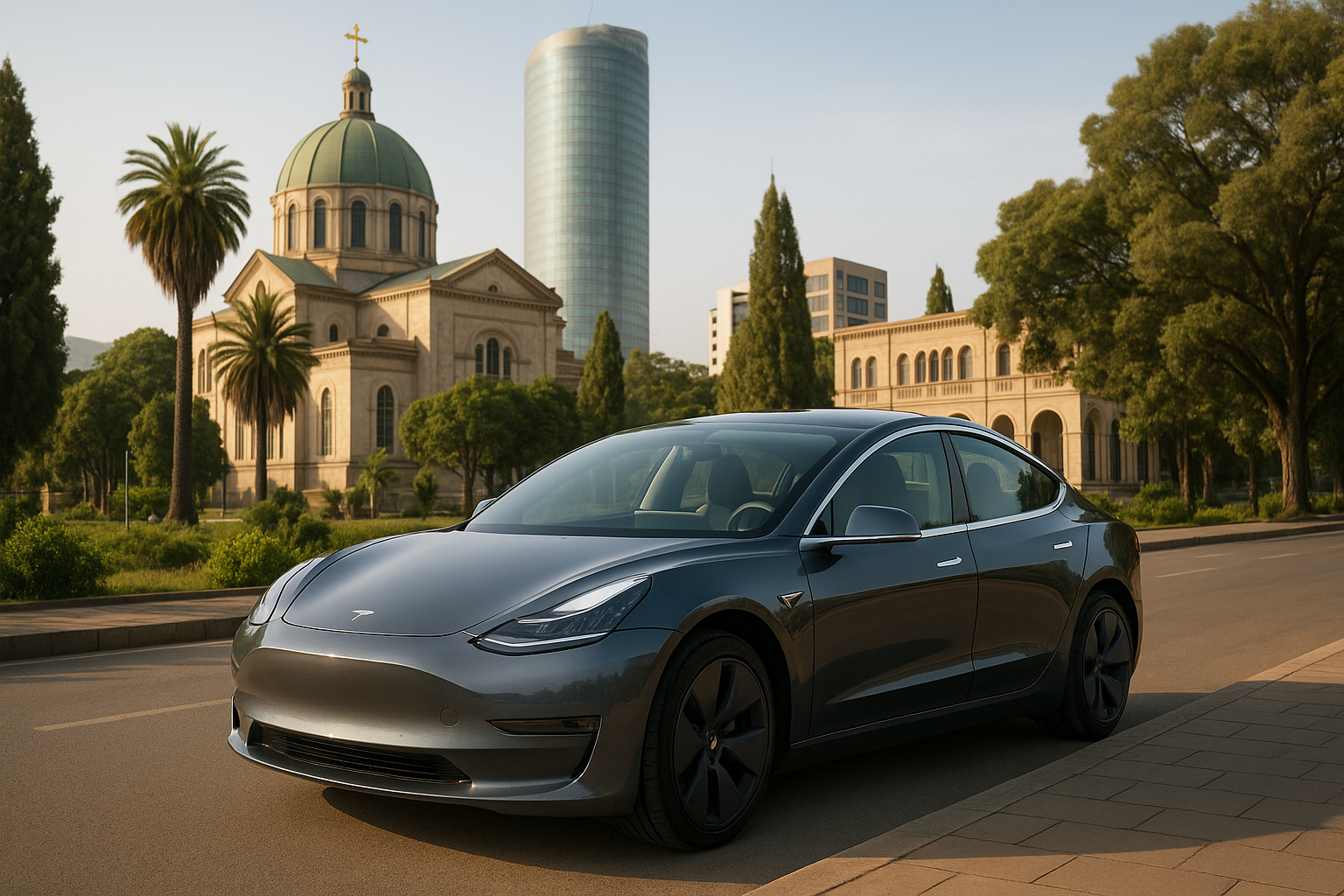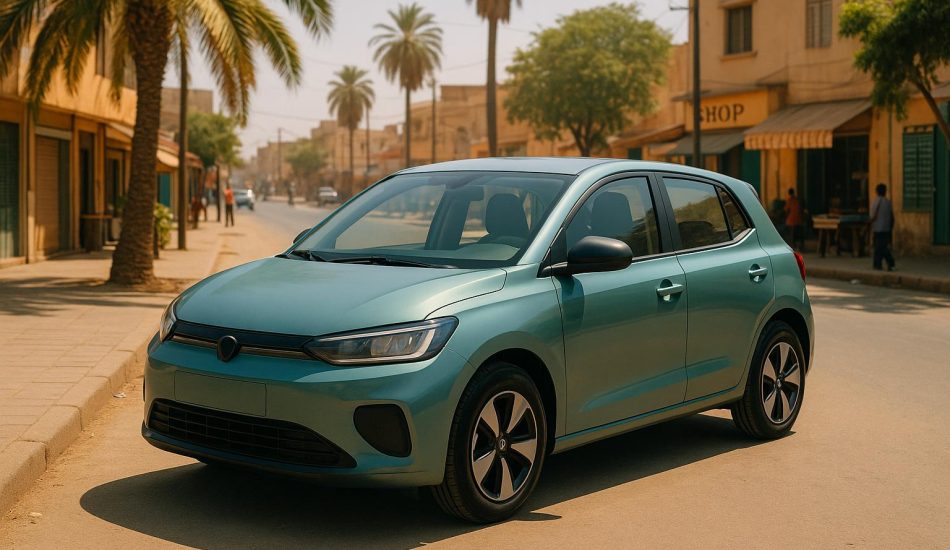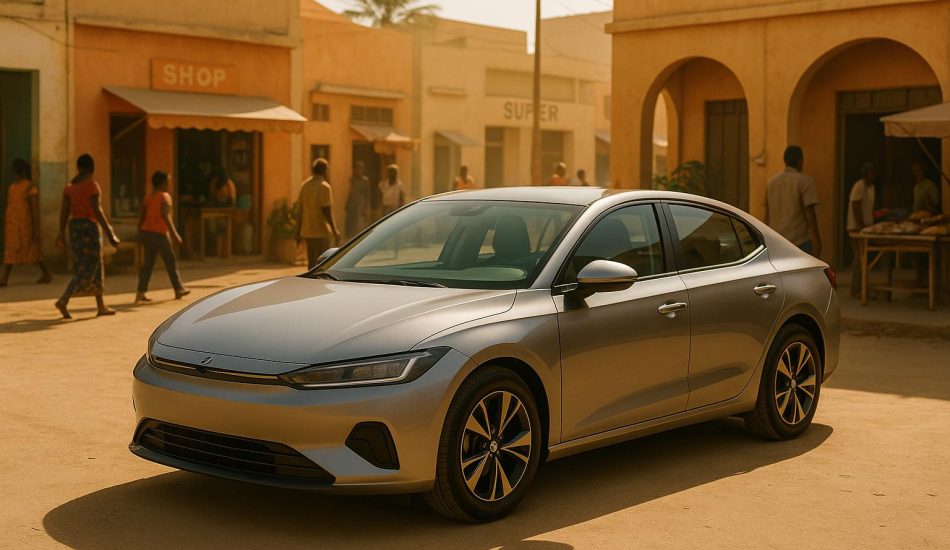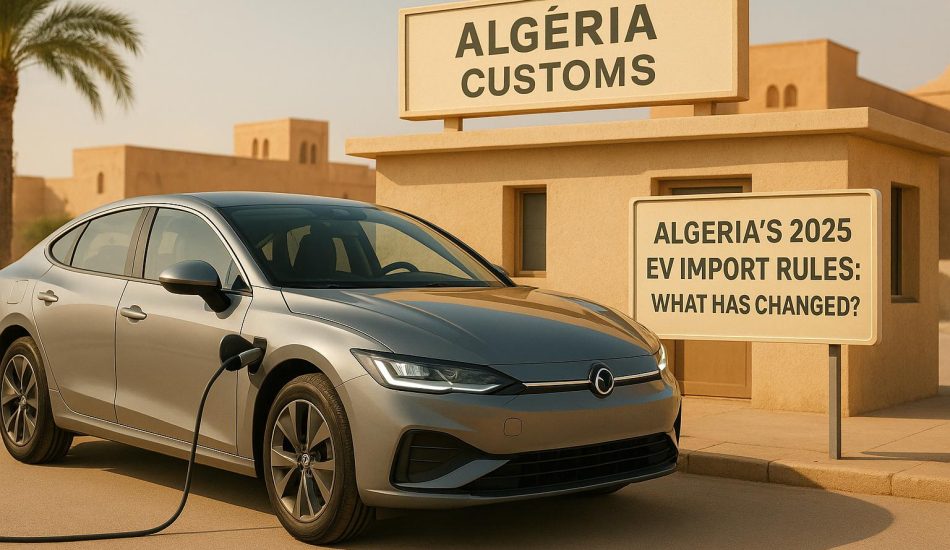
Tesla is making strides toward entering Ethiopia’s growing electric vehicle (EV) market. With high fuel costs, a population exceeding 120 million, and government policies encouraging EV adoption, Tesla’s presence is slowly expanding. Key models available in Ethiopia include the Model 3, Model Y, Model S, and the Roadster, with pricing influenced by import duties, shipping costs, and currency exchange rates. While charging infrastructure is still limited, home-based solutions and Ethiopia’s renewable energy potential make EV ownership feasible for urban buyers, especially in Addis Ababa.
Key Points:
- Models Available: Model 3 (affordable), Model Y (SUV), Model S (luxury), Roadster (sports car).
- Price Factors: Import duties, shipping, dealer markups, and currency fluctuations.
- Challenges: Limited charging stations outside cities and high upfront costs.
- Advantages: Lower long-term maintenance and fuel costs.
Tesla’s vehicles offer advanced technology and features tailored to Ethiopia’s diverse road conditions. However, potential buyers need to consider infrastructure readiness, financing, and maintenance options. Services like EV24.africa simplify the import and purchase process, making EV ownership more accessible in Ethiopia.
አዲስ Tesla Model X ስንት ይሸጣል በ አዲስ አበባ !! Car Price in Ethiopia #business #Amhariccarreview #car
Tesla Models Available in Ethiopia
Tesla’s range of vehicles in Ethiopia caters to various driving needs and preferences, with models accessible through specialized importers. Below is a closer look at what each model offers for Ethiopian drivers.
Model S
The Model S, Tesla’s luxury sedan, combines high-end performance with sleek design. Known for its rapid acceleration and extended range, this car is particularly appealing to Ethiopian drivers who often travel beyond urban areas where charging stations are scarce. Most buyers opt for versions with longer ranges to navigate Ethiopia’s diverse terrains with ease.
Model 3
As Tesla’s more affordable option, the Model 3 is a practical choice for city life in bustling areas like Addis Ababa. Its compact design, energy efficiency, and user-friendly digital controls make it an excellent fit for urban commuting. With multiple configurations available, the Model 3 has gained popularity among Ethiopian drivers seeking a balance of affordability and cutting-edge technology.
Model Y
The Model Y offers the versatility of a crossover SUV, making it ideal for families and drivers needing extra space. With optional third-row seating and ample cargo capacity, this model is perfect for larger households. Its efficient powertrain ensures steady performance across Ethiopia’s varied road conditions, from city streets to rural landscapes.
Roadster
Tesla’s Roadster is a sports car designed for speed enthusiasts. Its availability in Ethiopia is limited, requiring special import arrangements and expert maintenance. For those who appreciate high-performance vehicles, the Roadster offers an unmatched driving experience, albeit with added logistical considerations.
Tesla Prices in Ethiopia (2025)
Tesla’s presence in Ethiopia brings a mix of excitement and challenges, especially when it comes to pricing. The cost of owning a Tesla in the country reflects the complexities of importing luxury electric vehicles (EVs). Prices can vary widely based on the model, government regulations, and local market dynamics.
Price Ranges by Model
Tesla’s lineup offers options for different budgets, though even the most affordable models carry premium price tags due to import-related factors. The Model 3 is expected to be the most budget-friendly choice, appealing to buyers seeking an entry point into the Tesla experience. On the other hand, the Model Y and Model S, particularly their performance-focused versions, are likely to sit at the higher end of the spectrum. The Tesla Roadster, with its exclusivity and specialized import requirements, is expected to be the priciest option, catering to a niche market.
Key Pricing Factors
Several elements influence Tesla’s pricing in Ethiopia, making it essential for potential buyers to understand the breakdown:
- Import Duties and Tariffs: These can significantly inflate the base price of any Tesla model.
- Shipping and Logistics: Costs associated with transporting vehicles to Ethiopia, including regional transit, further add to overall expenses.
- Currency Exchange Rates: Fluctuations between the US Dollar and Ethiopian Birr lead to periodic price adjustments.
- Dealer Markups: Local dealers often add markups to cover services like warranty support, parts availability, and maintenance.
These factors collectively shape the pricing landscape for Tesla vehicles in Ethiopia, creating a premium market for these luxury EVs.
Price Comparison Summary
Tesla prices in Ethiopia vary based on the model, configuration, and additional costs like financing and dealer fees. For the most up-to-date pricing and options, it’s best to consult authorized Tesla dealers in the region.
sbb-itb-99e19e3
Specifications for Ethiopian Market
After discussing pricing, let’s dive into the technical features that Tesla has tailored for Ethiopia. These vehicles are equipped with cutting-edge technology designed to meet the unique demands of Ethiopian roads and infrastructure. Here’s a closer look at key aspects to help buyers make informed decisions.
Battery and Range
Tesla offers flexible battery options to suit various driving needs. The Model 3 comes with both standard and long-range battery configurations, making it suitable for city commutes as well as longer drives, such as from Addis Ababa to Bahir Dar. The Model Y, with its SUV design, not only offers an impressive range but also provides extra ground clearance, ideal for Ethiopia’s mixed road conditions. For those seeking even more range and reliability for extended trips, premium models like the Model S are a solid choice.
Larger battery packs ensure consistent performance, even in Ethiopia’s diverse climate, from cooler highlands to warmer lowlands.
Charging Options
Given Ethiopia’s developing infrastructure, Tesla provides versatile charging solutions. While dedicated Tesla Supercharger stations are not yet available, owners can rely on alternatives like the Mobile Connector, which allows basic charging from standard household outlets. For faster and more efficient home charging, the Wall Connector (a Level 2 charger) is an excellent upgrade, though its effectiveness depends on the home’s electrical setup.
Tesla vehicles are also compatible with a range of charging adapters, making them ready for emerging public charging networks as the country’s infrastructure evolves. Prospective buyers should ensure stable electricity access and proper installation of home charging equipment to maximize convenience.
Safety and Comfort Features
Tesla vehicles are packed with safety and comfort features designed to handle Ethiopia’s varied driving environments. Standard driver assistance technologies, such as adaptive cruise control and lane-keeping, are available across all models. For those opting for enhanced packages, additional features like advanced navigation tools can be unlocked. However, their full potential depends on the progress of local mapping and road data.
On the comfort front, Tesla’s climate control systems are designed to adapt to Ethiopia’s diverse weather conditions. Features like advanced air filtration, heated seats, and dynamic climate controls ensure a comfortable ride, whether navigating the cool highlands or the warmer lowlands. Safety is further bolstered by systems like automatic emergency braking, blind spot monitoring, and collision avoidance. And thanks to over-the-air software updates, Tesla vehicles can continuously improve their performance and add new features over time.
The Tesla mobile app enhances convenience by allowing users to remotely monitor charging, pre-set the cabin’s climate, and even locate their car – all from their smartphone. It’s this seamless integration of technology that makes Tesla ownership a connected and practical experience in Ethiopia.
Market Trends and 2025 Projections
Ethiopia’s electric vehicle market is still in its infancy, but interest in premium brands like Tesla is beginning to take root. While adoption remains limited, growing awareness around eco-friendly transportation signals a promising shift toward sustainable mobility in the years ahead.
Tesla Adoption in Ethiopia
Tesla ownership in Ethiopia is currently modest and primarily concentrated in major cities. The appeal lies in Tesla’s cutting-edge technology and commitment to sustainability, attracting a niche group of early adopters. However, with public charging infrastructure still in its infancy, many Tesla owners rely on private, home-based charging setups. These early developments are paving the way for a more dynamic market as we approach 2025.
2025 Price and Availability Forecasts
By 2025, several factors will influence Tesla’s pricing and availability in Ethiopia. Expanded global production and a broader range of Tesla models could result in more competitive pricing. However, local economic factors, such as currency fluctuations, will also play a role in determining affordability.
Improvements to Ethiopia’s electrical grid and the gradual rollout of public charging stations are expected to enhance the overall ownership experience. With more model options and potentially lower prices on the horizon, buyers will need to plan strategically to make the most of these advancements.
Buyer Considerations
For Ethiopian buyers, navigating the EV landscape requires careful thought about infrastructure, maintenance, and financing. Reliable access to charging is essential for daily use, especially as the public charging network develops. While Tesla vehicles are known for their low maintenance needs compared to traditional cars, the limited service network in Ethiopia means maintenance should still be a key consideration.
Financing options are also evolving to meet demand. For instance, platforms like EV24.africa streamline the process by offering support with financing, import logistics, customs clearance, and delivery across Ethiopia. This makes acquiring a Tesla more accessible for those ready to invest in premium electric vehicles.
As service networks improve and long-term cost savings become more evident, owning a Tesla in Ethiopia is becoming an increasingly attractive option for forward-thinking buyers.
Conclusion
Tesla’s growing presence in Ethiopia marks a pivotal moment for electric vehicles in East Africa. Though availability is still limited and prices remain steep, the landscape is gradually evolving as we move closer to 2025.
The Model 3 and Model Y stand out as the most practical choices, offering a balance of features, range, and relatively lower costs. These models are becoming even more appealing as charging networks expand and grid reliability improves.
For those considering Tesla ownership, preparation is key. Factors like securing financing, navigating import regulations, and ensuring access to dependable charging infrastructure are critical. Market conditions are shifting, promising more competitive pricing and greater availability in the near future.
To simplify the process, EV24.africa provides a seamless solution by handling financing, import logistics, and delivery within Ethiopia. With the right planning and support, owning a Tesla becomes more than just a purchase – it’s an investment in a cleaner, more sustainable future for transportation.
FAQs
What are the benefits and challenges of owning a Tesla in Ethiopia?
Owning a Tesla in Ethiopia presents a mix of perks and obstacles. On the bright side, Teslas come with lower maintenance costs compared to traditional gas-powered cars. They skip oil changes entirely and have fewer parts that need regular upkeep. Plus, they contribute to cleaner air by cutting down on carbon emissions, which is a win for the planet.
That said, there are some hurdles to keep in mind. Charging stations are still pretty scarce in Ethiopia, mostly found in urban centers, which can make longer trips tricky. Then there’s the price tag – Teslas are a big investment, putting them out of reach for many. Add to that the country’s broader economic challenges and relatively low vehicle ownership rates, and it’s clear why the shift to electric vehicles might take time.
If you’re considering making the leap to electric, it’s worth thinking through these factors and keeping an eye on how the market develops in the years ahead.
How do import taxes and currency changes affect Tesla car prices in Ethiopia?
Import taxes and currency swings play a huge role in shaping Tesla’s car prices in Ethiopia. Fully assembled electric vehicles (EVs) come with a hefty 20% customs duty, while semi-assembled units enjoy a much lower 5% duty. These taxes can dramatically drive up the cost of owning a Tesla.
Currency fluctuations add another layer of complexity. Changes in the Ethiopian Birr can push prices up or, occasionally, bring them down. For example, recent shifts in the exchange rate have sometimes made EVs slightly more affordable, though this depends entirely on the rates at the time of purchase.
In short, import taxes and currency volatility are the main forces behind Tesla’s pricing in Ethiopia, affecting everything from the base cost to the final price tag for buyers.
What charging options are available for Tesla owners in Ethiopia with the current infrastructure?
Tesla owners in Ethiopia have access to a limited but expanding network of charging stations, with the majority concentrated in Addis Ababa. Among these are a few ultra-fast charging hubs that were introduced in early 2025. Across the country, there are approximately 25 public charging stations, though rural areas still face major infrastructure challenges.
For now, home charging is the go-to solution for most Tesla owners, offering the most dependable option. Some drivers also set up private charging systems to supplement their needs as the public network continues to grow. While efforts to broaden coverage are in progress, anyone considering an EV in Ethiopia should carefully plan for charging access to ensure a smooth transition.




